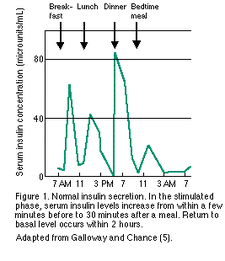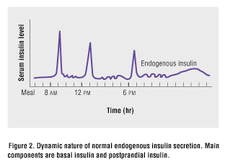
The Pancreas, from Gray's Anatomy
The pancreas[1] is the organ that produces the insulin hormone. The pancreas also produces glucagon[2], a hormone in opposition to insulin, which forces the release of glucose[3] into the bloodstream.
Although we focus mainly on its insulin-secreting capabilities, the pancreas is actually comprised of two sections. The endocrine area is connected with natural insulin production. The exocrine[4] area is connected with production of needed digestive enzymes, and is actually the larger of the two, by far[5]. Problems with the exocrine section of the pancreas can produce problems such as pancreatic insufficiency.
The pancreas produces hormones in the islets of Langerhans. Among them, glucagon is produced by the alpha cells, while insulin and amylin are produced in the beta cells. Somatostatin inhibits the release of all three, and is secreted by the delta cells.
Beta cells and insulin production[]

The pancreas has 2 separate sections, the exocrine, which deals with the digestive process, and the endocrine, which deals with the production of insulin (Beta cells) and glucagon (Alpha cells).
Healthy beta cells are constantly making insulin and storing it, as seen in this photo link below[6]. Those same beta cells release small amounts of insulin day & night, whether the person's eaten or not. This is how the body distributes its natural basal insulin. This is important to the body because it is the basal insulin which allows cells to use blood sugar.
When the insulin level drops, this signals the liver to release glucose by converting stored carbohydrates (glycogen) into glucose for fuel. This release and conversion raises blood glucose levels. It's the body's built in "fail-safe" mechanism to prevent hypoglycemia.
When this occurs, if there are not enough stored carbohydrates in the form of glycogen, the liver will convert protein into glucose in an attempt to keep the body going. If there's not enough carbohydrates or enough protein in the diet, the liver will begin turning body muscle into glucose to keep itself alive.
Glucose[7] is important enough to the bodies of all mammals that there are 5 different glucose transporters[8] which carry it to the various body cells. Each of them distribute glucose to a specific area of the body.
Normal insulin secretion[]
In those without diabetes, the healthy pancreas secretes insulin in pulses or spurts. Basal insulin secretion is a series of small pulses or spurts at a given rate day and night; these insulin pulses or spurts are to take care of the body's basic needs. When someone without diabetes eats a meal, the pancreas goes into higher gear, producing larger quantities of Post-prandial insulin to handle the additional glucose created by the food.
It is this pattern that diabetics try to mimic as closely as possible; with Basal insulin injections for the body's needs without considering food and Bolus insulin injections to cover meals replacing the Basal and Postprandial insulin their bodies no longer produce or do not produce in sufficient quantity[9].

Insulin secretion in non-diabetic human. The peaks represent the additional insulin released at meal times, called post-prandial, or after-meal insulin. Here you see how the non-diabetic body automatically calculates how much insulin is needed to handle the extra glucose generated by the meal and releases it.

Another view of endogenous (produced by the body) insulin production of a non-diabetic human. The basal, or body's needs minus the processing of food, insulin levels are the lower, often wavy lines shown. The sharp peaks represent how the body responds automatically with secretion of additional insulin to handle the extra glucose creating by eating meals, which are referred to as post-prandial (after-meals) on this graph. People using insulin try to re-create this pattern as much as possible by using fast or short-acting insulin at meal times.
When there's not enough beta cell insulin production to meet the body's basal needs, it can happen very quickly. The problem is when the beta cells aren't able to produce the needed insulin, the body interprets the low fasting insulin level as a sign the blood glucose levels need to be raised. The liver then dumps a large amount of glucose into the bloodstream, regardless if those levels are high or not. (Human diabetics refer to this as a liver dump.)
The failure of the first phase of insulin discussed above above is what brings about the vicious circle of glucose toxicity, which, in turn, damages even more of the insulin-producing beta cells.
For further information relevant to pet diabetes, see insulin, amyloidosis, and pancreatitis.
Further Reading[]
- Amylin Concentrations in Normoglycemic & Hypergycemic CatsThis 1996 study by Dr. Rand, et al, suggests that an excess of amylin may cause development of feline diabetes. See also amyloidosis.
- Journal of the Pancreas is free to read and contains many relevant articles on diabetes including feline and canine.
- great tutorial on insulin vs. glucagon
- The body's flexible uses of glucose.
- Functional Anatomy of the Endocrine Pancreas--Colorado State University School of Veterinary Medicine
- Histiology of the Pancreas--Endocrine & Exocrine--CSU School of Veterinary Medicine
- Pancreatic Islet Cells Interactive Map
By Mousing Over , the various cells of the pancreas and their actions are explained. - Interactive Pancreatic Beta Cells Tour
Mouse over the various areas to see how healthy pancreatic beta cells produce insulin.
References[]
- ↑ Wikipedia:Pancreas
- ↑ Colorado State University School of Veterinary Medicine-Glucagon
- ↑ National Institutes of Health (NIH) Illustration-How Glucose is Released Into the Body
- ↑ The Exocrine Pancreas
- ↑ Harvard-Human Pancreatic Acinar Cell Carcinoma Case
- ↑ Healthy Beta Cell--Insulin Granules Shown In Red
- ↑ National Institutes of Health (NIH)-Endocrinology-Glucose Turnover
- ↑ National Institutes of Health (NIH)-Glucose Transporters
- ↑ Postgraduate Medicine, White, et. al. 2003